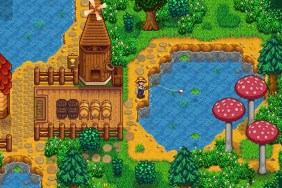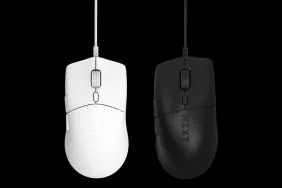The return of the ring.
I was about thirteen when I first encountered The Lord of the Rings trilogy. Hard bound with big fold-out maps, the tome resided on my parent’s bookshelf, though they probably never read it. Familiar with The Hobbit, I brushed the dust off The Fellowship and dug in.
By the end of Bilbo’s one-hundred-and-eleventieth birthday party, I was hooked. I spent the next two days pretending to be sick so that I could skip school and obsess over the amazing plot. Gripped by the lure of the ring, I read the entire trilogy in one long marathon session with breaks only to sleep and eat. Lembas bread, naturally.
[image1]Mine is a tale shared by millions of geeks, but despite the continued popularity of the books, I think it’s safe to say that more people are familiar with the trip to Mordor because of Peter Jackson’s (admittedly sweet) movie version. While the original LOTR: The Battle for Middle Earth stuck very closely to the films, Battle for Middle Earth II falls somewhere in between, using many elements from the film, borrowing more from the rich literary mythos, and then taking a few liberties of its own.
Once again, the game takes place during the events portrayed in the trilogy. Sauron is mustering his forces, the good guys are mustering their wits, and Frodo has to get that damn ring into that cursed mountain. None of this should be new to anyone with a pulse.
There are, however, a slew of new features in this sequel.
The biggest change is certainly in the buildings. You can now build wherever you choose, instead of being limited to very specific locations. To support this more traditional base building structure, there is also an elaborate system of wall building and defensive structure upgrades.
However, the game still forces you to spread your encampment far and wide with its new resource gathering system. Structures such as farms, slaughterhouses, or Mallorn trees will automatically produce the game’s single resource, cleverly named “resources.” The effectiveness of a resource gatherer is dependant on the large area of unused land around it, so placing a farm too close to another farm does you no good.
It’s an interesting idea in that it tries to balance both defense and territorial control, but ends up flawed because the structures are flimsier than the Hollywood facades from the film. It turns out that half the units can climb or fly over the walls anyway, and the other half can knock them down just as fast. Every building, including those widespread farms, can be razed in just a few seconds when confronted by even a single enemy unit. As a result, you simply have to invest all your resources into your mobile army, as trying to build defensible bases is pointless.
It’s not a huge loss, though, since the units are far more satisfying than the buildings. Battle for Middle Earth II features a generous six sides: the Men of the West, the Elves, the Dwarves, Isengard, Mordor, and the Goblins all have their own axes to grind. You can also take to the sea in new naval vessels, but while they look good, they don’t come into play very often since the game sticks to the known peninsula of Middle Earth and does not include any of the lands across the sea.
Even more fun are the plentiful hero units. Over 30 ultra-powerful characters hail from the original Fellowship, the stories of Tolkien, the movies, and the minds of the developers. Though you can bring Gandalf into a battle you know he had no part in, it’s still uniquely satisfying to watch him destroy whole battalions of orcs. Or, if you feel a bit evil, to watch your Fellbeast hero plummet from the sky, smashing into a formation of Gondorian soldiers, scattering them like twigs, then grabbing one in a giant taloned claw, ascending back into the sky and tossing the unlucky fool to plummet to his death. I could be entertained by this endlessly.
[image2]But if you need another hero, you can try your hand at the new Create-a-Hero feature and put your own unique wind beneath your wings. The customization is a little thin, giving you only a few costume and color options and limited skill specialization, but it’s still nice to be able to drop your avatar down into the thick of things to kick some elf ass.
Both your heroes and your units gain experience from their battles and become more powerful, which is great. Unfortunately, you won’t get to carry your units over to the next one, and even when you do, it’s only a certain few. This makes the unit advancement much less satisfying than it could be.
The Battle for Middle Earth II has split the single-player experience in two. There are both good and evil campaigns, but each one only has 8 missions, so you’ll be done with them before you know it. More interesting is the remake of the original mission system, now dubbed “The War of the Ring” (no connection to that earlier Warcraft III clone.)
Here you select your own conflicts from a Risk style map of the regions of Middle Earth. Use your territories to create heroes and armies, then march them off to war. You can always build more troops on the battlefield, but only the ones from your strategy map will retain experience or even survive the battle, win or lose. Likewise, any buildings or bases you have built during a battle similarly disappear.
Each area of Middle Earth also confers a specific bonus, and more bonuses can be obtained by uniting a region, just like in Risk. However, each region also only allows you to build two buildings of four possible buildings, and there’s no diplomatic model whatsoever. It’s a nice addition, but plays like a moron’s version of Rome: Total War more than a solid stand-alone game.
Taking your battle across the Internet will alleviate some of that shallowness, but not all of it. On top of all the regular skirmishes, you can also play out a whole game of War of the Ring online, which makes for a much more interesting opponent than the flaccid CPU. This can take (literally) days, however, and without Civilization IV‘s round-robin innovation, you’ll have to save your online game and reschedule with your opponent to finish it. But even online, the strategy is a bit lacking since it is so difficult to protect your resources. Every battle, it seems, turns into a race to destroy each other’s fragile, far-flung resource buildings rather than a contest of military tactics.
[image3]But while the strategy might not run as deep, in many ways it looks more impressive than any other RTS out there, thanks to the variety of units and the awesome engine. There’s a visceral, cinematic feel to the combat here that truly needs to be experienced; bodies go flying as trolls swing massive stone clubs and goblins fall under the trampling hooves of a cavalry charge. Save up enough power points to summon a Balrog for a particularly impressive display of carnage. With great modeling, a steady framerate and all kinds of bells and whistles, this is as pretty as war can get.
The sound is equally impressive as Orcs roar with rage and the Men of Gondor shout rallying calls. Many of the actors from the movie have reprised their roles for their gaming counterparts, and Elrond (actor Hugo Weaving) provides the narration. The excellent film score has also made the migration and dramatically sets the backdrop.
However, I don’t think it’s exactly the right backdrop for this kind of game. The story of Frodo and the Fellowship is much more like a survival-horror game than this giant war effort. The characters in The Lord of the Rings spend far more time running and hiding than they do fighting. Perhaps it would fare better as a tactical game ala the classic Myth series, where your units are precious and irreplaceable. It just doesn’t make any sense that I can endlessly create more immortal elves from the barracks or more Ents from the Ent Moot. Boromir died, dammit. I should not be able to resummon him as often as I like as long as I have the “resources.”
But that being said, there’s still no way to deny that The Battle for Middle Earth II is simply a lot of fun. The venerable mythology and frenetic battles come together in a very satisfying bundle. Sauron won’t be the most intelligent opponent you’ll ever face, but he might be one of the most entertaining.
-
Terrific graphics
-
Cool units
-
Good fun
-
Shallow strategy
-
Short campaign
-
Paper mache buildings











